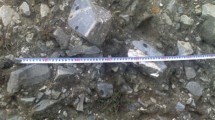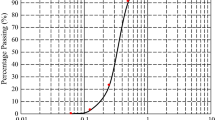Abstract
In the past three decades, fracture mechanics (FM) of brittle and quasibrittle materials have developed mainly in concrete applications and has yet to gain its rightful place in the geotechnical field. There are many examples in the geotechnical literature, especially those related to brittle and stiff soils, where traditional approaches of analysis have proven to be inadequate. While geotechnical problems are inherently complex in nature, the use of computational fracture mechanics have been shown to provide a powerful tool that could be used to investigate and solve many application problems in geomechanics and geotechnical engineering. This paper addresses the application of FM concepts and theories in analysis of cemented soils. In addition to theoretical aspects, experiments were conducted to evaluate the application of FM to cemented soils. Three-point bending beam tests with crack mouth opening displacements (CMOD) conducted on cemented sand samples showed that fracture parameters, such as CMOD, indeed could play an important role in investigation of such soils. Using this unambiguous material parameter, field engineers might have a reliable measure that could prove to be useful in stability assessment of earth structures and soil structure system. By studying size effect on cemented sand, strong relationship was established between critical CMOD and failure, which might be a very useful index and analysis tool in geotechnical engineering practice.
Similar content being viewed by others
References
Anderson, T.L. (1995). Fracture Mechanics, Fundamentals and Applications, CRC Press, Ann Arbor, (2nd edn).
Ayari, M.L. (1994). Simex, User's Manual, University of Manitoba, Canada.
Babuska, I. and Miller, A. (1984). The post-processing approach to finite element method — Part II: The calculation of stress intensity factors. International Journal for Numerical Methods in Engineering 20, 111–129.
Barsoum, R.S. (1974). Application of quadratic isoparametric finite element in linear fracture mechanics. International Journal of Fracture 10, 603–605.
Bishop, A.W. (1967). Shear strength of OC clays. Proceedings of the Geotechnical Conference 2, 153–154.
Bishop, A.W. and Little, A.L. (1967). The influence of the size and orientation of the sample on the apparent strength of London clay at Malden, Essex. Proceedings of the Geotechnical Conference 1, 89–96.
Bjerrum, L. (1967). Progressive failure in slopes of OC plastic clay and clay shales. Journal of Soil Mechanics and Foundations, ASCE 93(SM5), 3–49.
Bjerrum, L., Nash, J.K.T.L., Kennard, R.M. and Gibson, R.E. (1972). Hydraulic fracturing and field permeability testing. Géotechnique 22(2), 319–332.
Briaud, J.L. (1986). Pressuremeter and foundation design, ASCE Specialty Conference — The Use of In Situ Tests in Geotechnical Engineering, Blacksburg, VA, June, 74–85.
Broek, D. (1991). Elementary Engineering Fracture Mechanics, Kluwer Academic Publishers (4th edn).
Butterfield, (1986), Personal communication with Stein Sture.
Cai, W.M., Murti, V. and Valliappan, S. (1990). Slope stability analysis using fracture mechanics approach. Theoretical and Applied Fracture Mechanics 12, 261–281.
Erdogan, F. and Sih, G.C. (1963). On the crack extension in plates under plane loading and transverse shear. Journal of Basic Engineering 85, 519–527.
Fang, H.-Y. (1994). Cracking and fracture behavior of soils. ASCE, Geotechnical Special Publication No. 43 — Fracture Mechanics, Applied to Geotechnical Engineering, Oct. 9–13 (Edited by L.E. Vallejo and R.Y. Liang), Atlanta, Georgia, 102–117.
Fang, H.-Y., Mikrudis, G.K. and Pamukcu, (1989). Fracture behavior of compacted fine-grained soils. ASTM STP 1020 — Fracture Mechanics, Perspectives and Directions (Edited by R.P. Wei and R.P. Gangloff) Philadelphia, 659–667.
Gould, J.P. (1960). A study of shear failure in certain tertiary marine sediments. Proceedings of ASCE Conference on the Shear Strength of Soils, Boulder, Colorado, 615–641.
Griffith, A.A. (1921). The phenomena of rupture and flow in solids. Philosophical Transaction of the Royal Society of London A 221, 163–197.
Haberfield, C.M. and Johnson, I.W. (1989). Relationship between fracture toughness and tensile strength for geomaterials. Proceedings of 12th International Conference of Soil Mechanics and Foundations, Rio de Janeiro, Brazil, Vol. I, 47–52.
Haberfield, C.M. and Johnson, I.W. (1990). Determination of the fracture toughness of a saturated soft rock. Canadian Geotechnical Journal 27(3), 276–284.
Harison, J.A. and Hardin, B.O. (1994). Cracking in clays: Solutions to problems in earth structures. International Journal for Numerical and Analytical Methods in Geomechanics 18, 467–484.
Harison, J.A., Hardin, B.O. and Mahboub, K. (1994). Fracture toughness of compacted cohesive soils using ring test. Journal of Geotechnical Engineering, ASCE 120(5), 872–889.
Henshell, R.D. and Shaw, K.G. (1975). Crack tip elements are unnecessary. International Journal of Numerical Methods in Engineering 9(3), 495–509.
Hussain, M.A., Pu, S.L. and Underwood, J.H. (1974). Strain energy release rate for a crack under combined mode I and mode II. Fracture Analysis, ASTM, STP 560, 2–28.
Ingraffea, A.R. and Manu, C. (1980). Stress-intensity factor computations in three dimensions with quarter-point elements. International Journal for Numerical Methods Engineering 15(10), 1427–1445.
Irwin, G.R. (1957). Analysis of stresses and strains near the end of a crack traversing a plate. Journal of Applied Mechanics, Transaction ASME 24, 361–364.
Jenq, Y.S. and Shah, S.P. (1985). A two parameter fracture model for concrete. Journal of Engineering Mechanics Division, ASCE 111(4), 1227–1241.
Lajtai, E.Z., Carter, B.J. and Ayari, M.L. (1990). Brittle fracture criteria for compression. Engineering Fracture Mechanics 37(1), 59–74.
Lee, F.-H., Lo, K.-W. and Lee, S.-L. (1988). Tension crack development in soils. Journal of Geotechnical Engineering, ASCE 114(8), 915–930.
Lo, K.Y. (1970). The operational strength of fissured clays. Géotechnique 20(1), 57–74.
Lo, K.Y. (1972). An approach to the problem of progressive failure. Canadian Geotechnical Journal 9, 407–429.
Lutton, R.J. (1969). Fractures and failure mechanics in loess and applications to rock mechanics. Research Report S–69–1, US Army Corps of Eng. Waterways Experiment Station, Corps of Eng., Vicksburg, Miss.
Mitchell, J.K. (1976). Fundamentals of Soil Behavior, John Wiley and Sons, New York.
Morgenstern, N.R. and Tchalenko, J.S. (1967a). Microscopic structures in Kaolin subjected to direct shear. Géotechnique 17, 309–328.
Morgenstern, N.R. and Tchalenko, J.S. (1967). Microstructural observations on shear zones from slip in natural clays. Proceedings of Geotechnical Conference 2, 146–152.
Mould, J.C., Jr. (1983). Stress Induced Anisotropy and the Evaluation of Multi-surface Elasto-plastic Material Model, PhD thesis, University of Colorado, Boulder.
O'Rourk, T.D. and Crespo, E. (1988). Geotechnical properties of cemented volcanic soil. Journal of Geotechnical Engineering, ASCE 114(10), 1126–1147.
Owen, D.R.J. and Hinton, E. (1983). Engineering Fracture Mechanics: Numerical Methods and Applications, Pineridge Press, Swansea, UK.
Palmer, A.C. and Rice, J.R. (1973). The growth of slip surface in the progressive failure of OC clay. Proceedings of the Royal Society of London A332, 527–548.
Rice, J. (1968). A path independent integral and the approximation of strain concentration by notches and cracks. Journal of Applied Mechanics, Transaction of ASME 35, 379–386.
Rizkallah, J. (1977). Stress-strain behavior of fissured stiff clays. 9th International Conference on Soil Mechanics and Foundations 1, 267–270.
Saada, A.S., Chudnovsky, A. and Kennedy, M.R. (1985). A fracture mechanics study of stiff clays. Proceedings of the 11th International Conference in Soil Mechanics and Foundations 2, 637–640.
Saouma, V., Broz, J.J. and Brühwiler, E. (1991). Effect of aggregate and specimen size on fracture properties of dam concrete. Journal of Materials in Civil Engineering, ASCE 3(3), 204–218.
Shah, S.P., Swartz, S.E. and Ouyang, C.-S. (1995). Fracture Mechanics of Concrete, John Wiley and Sons, New York.
Shih, C.F., de Lorenzi, H.G. and German, M.D. (1976). Crack extension modeling with singular quadratic isoparametric elements. International Journal of Fracture 12, 647–651.
Sih, G.C. (1973). Hand Book of Stress-Intensity Factors for Researchers and Engineers, Institute of Fracture and Solid Mechanics, Lehigh University, Bethlehem, Pa.
Sih, G.C. (1974). Strain energy factors applied to mixed mode crack problems. International Journal of Fracture 10, 305–000.
Sih, G.C., Paris, P.C. and Erdogan, F. (1962). Crack-tip intensity factors for plane extension and plate bending problems. Journal of Applied Mechanics, Transaction of ASME 29, 306–312.
Sih, G.C., Paris P.C. and Irwin G.R. (1965). On cracks in rectilinearly anisotropic bodies. International Journal of Fracture Mechanics 1(3), 189–203.
Sih, G.C. and Liebowitz, H. (1968). Mathematical theories of brittle fracture. Fracture an Advanced Treatise (Edited by H. Liebowitz) 2, 68–188.
Simons, N.E. (1967). Discussion on shear strength of stiff clay. Proceedings of the Geotechnical Conference 2, 159–160.
Sitar, N., Clough, G.W. and Bachus, R. (1980). Behavior of Weakly Cemented Soil Slopes under Static and Seismic Loading Conditions, final report prepared for the United States Geological Survey, Department of Interior. (June).
Skempton, A.W. (1964). Long-term stability of clay slopes. Géotechnique 14, 77–101.
Skempton, A.W. (1966). Some observations on tectonic shear zones. Proceedings of 1st International Congress on Rock Mechanics, Lisbon, Portugal, 329–335.
Standard Test Method for Plane Strain Fracture Toughness of Metallic Materials, ASTM Designation E399–74, Part 10, ASTM Annual Standards.
Sture, S., Swanson, R., Al-Shibli, K., Jeremic, B. and Zhang, R. (1994). Mechanics of Granular Materials: Experiments, University of Colorado Research Report, NASA No. NAS8–38779, August, 305.
Taylor, D.W. (1948). Fundamentals of Soil Mechanics, John Wiley and Sons.
Terzaghi, K. (1936). Stability of slopes of natural clay. Proceedings of 1st International Conference of Soil Mechanics and Foundations 1(G-7), 161–165.
Tracey, D.M. (1977). Discussion — On the use of isoparametric finite elements in linear fracture mechanics — R.S. Barsoum. International Journal for Numerical Methods in Engineering 11, 401–402.
Vallejo, L.E. (1985). Fissure interaction and progressive failure of slopes. Proceedings of 11th International Conference of Soil Mechanics and Foundations, San Francisco 4, 2353–2356.
Vallejo, L.E. (1986). Mechanics of crack propagation in stiff clays. Proceedings of ASCE Specialty Conference (Geotechnical Aspects of Stiff and Hard Clays), Seattle, 14–27.
Vallejo, L.E. (1987). The influence of fissures in stiff clay subjected to direct shear. Géotechnique 37(1), 69–82.
Vallejo, L.E. (1989). Fissure parameters in stiff clays under compression. Journal of Geotechnical Engineering, ASCE 115(9), 1303–1317.
Westergaard, H.M. (1939). Bearing pressure and cracks. Journal of Applied Mechanics, Transaction of ASME 61, A49-A53.
Williams, M.L. (1957). On the stress distribution at the base of a stationary crack. Journal of Applied Mechanics, Transaction of ASME 24(109), 109–114.
Wroth, C.P. (1986). Personal communication with Stein Sture.
Zienkiewicz, O.C. and Taylor, R.L. (1989). The finite element method, Vol. 1: Basic Formulations and Linear Problems, McGraw Hill, London (4th edn).
Author information
Authors and Affiliations
Rights and permissions
About this article
Cite this article
Sture, S., Alqasabi, A. & Ayari, M. Fracture and size effect characters of cemented sand. International Journal of Fracture 95, 405–433 (1999). https://doi.org/10.1023/A:1018637309530
Issue Date:
DOI: https://doi.org/10.1023/A:1018637309530




